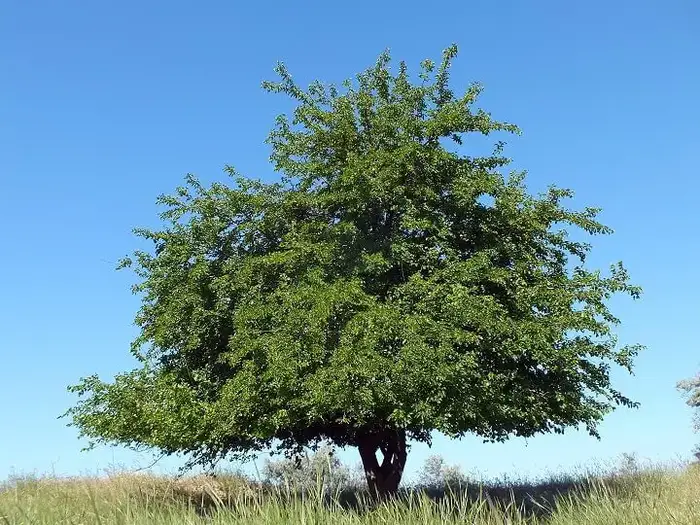
Trees are a homesteader’s best friend. They provide shelter from the sun, wind, and rain, as well as protection from intruders. They often have medicinal properties or produce food—or both. Firewood is yet another benefit, and it’s essential for homesteaders who are off the grid.
Most homesteaders who purchase a property find themselves wishing that the previous owners had planted more trees. But as the Chinese proverb says, “The best time to plant a tree was 20 years ago. The second best time is now.”
While there are plenty of options when it comes to trees you can plant, it’s important to note what your end goal is. An orchard of apple trees would be great for providing fruit year after year, while a line of evergreens would be beneficial as a windbreak. Cedar trees provide beautiful wood that can be used to build, while maples provide an excellent amount of shade for both the yard and the home.
It was hard for me to narrow down the one tree that every homesteader should plant. However, if you only had the resources to purchase or pick one tree, we think the mulberry tree would be the best one. While some believe that this is a rather messy tree, I believe its benefits outweigh the negative.
Here’s why we chose the mulberry tree as the tree that every homesteader should plant:
Mulberry Trees Grow Quickly
A vital component of choosing the best tree involves the amount of time it takes the tree to grow. While there are plenty of beautiful and majestic trees, many are slow-growing, which significantly diminishes their value in the short term. Mulberry trees, however, can grow up to 10 feet each year, making them an excellent choice.

Take advantage of this quick-growing tree to use along the property lines of the homestead. Not only will the trees look lovely, but they will grow quickly enough that they can help add a hedge of protection to the home from the wind, snow, rain, and even other people. You can help expand your mulberry trees using cuttings from one tree to create many different trees.
When growing trees to use as wood fuel, mulberry trees often produce more wood per acre than most other trees, thanks to their quick growth rate. The wood is often used as firewood but could also come in handy for other small projects. The berries are also quick to appear on a young tree, adding to their ability to be useful sooner rather than later.
However, it is important to note that mulberry trees are often regarded as invasive or overbearing thanks to their growth rate. Make sure to plant a mulberry tree far away from the home and permanent structures as their root systems can cause havoc on foundations. The key to using mulberries on the homestead is to plant them far away from anything else for the best experience.
Mulberry Trees Produce Fruit
Gathering food sources is the primary job of any homesteader. You not only grow a garden but also raise animals to provide either dairy or meat for the family. This was why it was important for us to choose a tree that also offered some sort of edible.
Mulberries are great to eat straight off the tree and are often used as a substitute for blackberries and raspberries. You can use them in a variety of recipes and even make delicious mulberry wine as well. One of the best parts of the mulberry tree is that you can also use the stem, leaves, and bark to create edible items.
Mulberries taste somewhat like grapefruit and are often used to create jams and jellies that are so valuable on the homestead.
Mulberries Provide Health Benefits
Keeping your family safe from disease and injury is another essential part of living on the homestead. Mulberries were used in ancient Chinese medicine to help treat diabetes, arthritis, and even heart disease.
Many use mulberries to help improve digestive systems as well. They can help with constipation thanks to their fiber content. Mulberries have also proven their ability to help lose weight.
Mulberries are also believed to reduce the risk of cancer thanks to their high level of antioxidants. They also help control blood pressure and assist in overall blood circulation. They are also rich in iron, making them an important food source for those who struggle with anemia.
Mulberries Used in Textiles
While you can find a wide variety of mulberry trees that bear white, blue, and black mulberries, most homesteaders will find their mulberries ripen to a deep red color in late May or early June. This dark-colored fruit often stains the hands of those picking the berries, as well as any light-colored surface located underneath the tree.
You can use the dark color of the berries to dye fabric or textiles on the homestead when you’ve had your fill of the fruit. A little bit of juice from these dark berries goes a long way in staining fabric to use all around the homestead.
While you may regret not planting trees every year, you’ll seldom regret planting trees on the farm. Different varieties of trees offer a wide range of benefits, but we think the mulberry tree is the one option that will give you the most bang for your buck. When choosing just one tree to plant this year, consider the mulberry tree for its multiple uses and delicious fruit.
